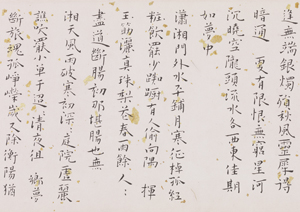Essay
In 1949 Chang Ch’ung-ho Frankel (born 1913) moved to the United States with her husband Hans Frankel (1916–2003), a German Sinologist. They first taught at the University of California at Berkeley, then at Stanford University, and finally moved to Yale University in 1961.Qianshen Bai, “Zhang Chonghe de shengping yu yishu” 張充和的生平與藝術. In Qianshen Bai ed., Selected Works of Chang Ch’ung-ho’s Poetry, Calligraphy, and Painting (Beijing: SDX Joint Publishing Company, 2010): 20. Their house in Connecticut has a backyard where Chang Ch'ung-ho plants flowers, vegetables, fruit, and bamboo.Qianshen Bai, “Zhang Chonghe de shengping yu yishu” 張充和的生平與藝術. In Qianshen Bai ed., Selected Works of Chang Ch’ung-ho’s Poetry, Calligraphy, and Painting (Beijing: SDX Joint Publishing Company, 2010): 20. This backyard, which she calls “Small Garden,” has given her much joy and fulfillment, inspiring her to compose ten poems about it.Refer to Zhang Chonghe shu張充和書, Sun Kangyi 孫康宜ed., Zhang Chonghe tizi xuanji 張充和題字選集 (Hong Kong: Oxford University Press (China) Ltd, 2009: 13-15.
This handscroll, which features four of the “Small Garden” poems, were written on a rainy summer's day in 1978, the year of wuwu (戊午), when Chang was sixty-five years old. These four poems were written in an ancient form of cursive script known as the “draft cursive script (zhangcao章草),” developed and popularized during the Han dynasty (206 b.c.–a.d.220). Draft cursive script has its origins in the quick writing of seal script (zhuanshu 篆書), and incorporates certain qualities of clerical script (lishu 隸書), such as bozhe 波磔, which refers to varying the pressure on the brush in left and right downward strokes. The strokes of each character are simplified and connected, but the characters are not linked together.The introduction of the draft cursive script, refer to Ouyang Zhongshi, Wen C. Fong (et al.), Wang Youfen ed., Chinese Calligraphy (Beijing: Foreign Languages Press; New Haven: Yale University Press, 2008): 34,37, 61-62,128-130. All these characteristics are visible in the masterful calligraphy of this handscroll.
Since Chang Ch'ung-ho is best known for her standard script, her draft cursive script is relatively rare. Chang practiced calligraphy on a daily basis.Ibid. Just prior to writing this handscroll on that rainy day in 1978, she may have been practicing “draft cursive script.” Perhaps that is why she modestly signs this work “Chung-ho, who is learning (to write) cursive script” (Chonghe xuecao 充和學草).
Seven years later, in 1985, Chang re-wrote the ten poems in small standard script, and painted ten landscape paintings in the style of Mi Fu 米芾 (1051–1107), Ni Zan 倪瓚 (1301–1374) and Dong Qichang 董其昌 (1555–1636) to form an album of poetry, painting and calligraphy, known as the “Three Perfections” (sanjue 三絕).The introduction and image of this album, refer to note 2, p.190-200. Also, Qianshen Bai, “Literati Legacy in the Modern Era: Ch’ung-ho Chang Frankel and Friends,” in Mimi Gardner Gates ed., Fragrance of the Past: Chinese Calligraphy and Painting by Ch’ung-ho Chang Frankel and Friends (Seattle: Seattle Art Museum, 2006): 18. Given the emphasis which she placed on "Small Garden," clearly it was a singular and special place in Chang’s daily life. Perhaps the Small Garden is her utopia, her “Peach-blossom Spring.”
© 2013 by the Seattle Art Museum
Questions for thought
Answers
| Add an answerAdd Answer:
overview
Chang Ch'ung-ho Frankel張充和
Quick Facts about the Artist
Raised in a prominent family in Hefei, Anhui province.
Attended westernized middle school and was taught at home by private teachers chosen by her grandmother. She received an intensive classical Chinese education, including kunqu opera.
Admitted to Peking University in 1934.
Met her esteemed calligrapher teacher and mentor, Shen Yinmo沈尹默 (1883–1971), one of the most influential calligraphers of twentieth-century China, during the WWII.
Met Hans Frankel (1916–2003), a German scholar of comparative literature and a Sinologist specializing in the study of Chinese poetry.
They married in 1948 and subsequently moved from China to the United States in 1949.
Best known for her small standard script (xiao kai 小楷).
inscriptions and seals
essay
In 1949 Chang Ch’ung-ho Frankel (born 1913) moved to the United States with her husband Hans Frankel (1916–2003), a German Sinologist. They first taught at the University of California at Berkeley, then at Stanford University, and finally moved to Yale University in 1961.
